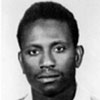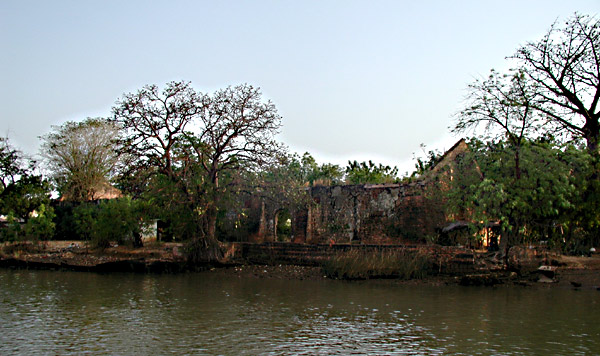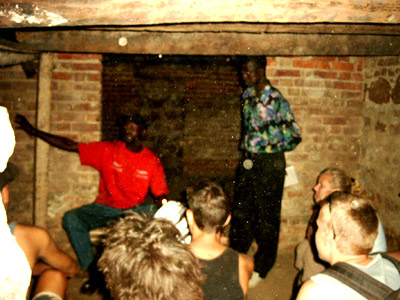| Author |
 Topic Topic  |
|
kondorong

Gambia
4380 Posts |
 Posted - 03 Nov 2006 : 20:35:19 Posted - 03 Nov 2006 : 20:35:19


|
I am beginning to doubt if the "so called slave house in Maccarty just by the ferry terminal is actually a slave house.
Historical evidence showed that, the island was purchased in 1785 from a local chief for the sum of 1000.00 pounds. This is indicated in the Report of the King's servant to the House of Commons committee respecting purchase for the crown of Leemain Island in the River Gambia. Please see Colonial Office 267/21 Kew at the Public Records Office in London.
Maccarthy is a very recent name. At the time of purchase, it was call Janjang bureh meaning refuge. When the British enetered the island in 1785, there was a settlement on the island called Moro Kunda a mandinka word meaning The House of the Religious people. The population was 200 muslims seeking refuge from non muslim kings in the area.
However the earlier name which appeared on the maps of Senegambia by 1700 under the expedition of D'anville named it Lemaine Island. Actually, Lemaine is a corrupted name of Abdul Lamin a muslim scholar. Therefore both accounts confirmed the island as refuge by Muslims both by 1700 and 1785 when it was bought by the British.
The name George town was from the first fort built in 1823 called Fort George. It was a mud fort and therefore since disappeared. The second fort built was Fort Cambell. Its indicated that this fort was built at a point on the island where the crossing was the shortest and two cannons placed there. Could this be sankulay kunda or Tumani Tenda on the other side leading to Fulladu Tabanani.
The island was founded as a refuge for freed slaves by the british and also a home for Liberated Africans from Sierraleone. It was not founded on slavery since by 1785, no western settlement was on the island or some organised commerce of some form visible then.
Many of the liberated africans on the island were Ghanians and Nigerians but many died. So next time you see a Ghanian or a Nigeraian, he may be your long lost cousin especially if you have roots in the island. A colonial Office report in 1837 said "... that nearly one-half of the whole number brought here must have perished..".
The initial reason for buying the island was to send convicted British felons there to serve their sentences because by 1776, with american independence, Britain lost a vast colony for sending felons. They had to look elsewhere and gambia provided hope.
Sierralone was the dumpsite for slave ships captured in atlantic for two reasons.
1. Most liberated slaves could not make journeys to where they came from
2. The british also believd that trying to resettle them in their homes would lead to enslavement again. Once a slave always a slave.
Fort George which later became Gorgetown, was said to have been built in the middle of the island. If my memeory serves me right, this place must be just behind Armitage High School because out there, one can find traces of settlements and gravesites with British names.
The name maccarthy came about when it was named after the Governor of Sierraleone- Sir Charles Maccarthy.
The "slave house" at the feery terminal is believe to be a barn for food for liberated slaves since according the asylum law then, the crown was responsible for their up keep for six months(food, clothing and housing). However with over 100,000 liberated slaves captured from ships in the high seas, the cost became unmanageable and the peiod of help was lessened to and they were forced to join apprenticeship programmes to be independent. However, the conditions of the programme were "... most abominable; it is nothing more than Slavery of the worst description....) (Lieutnat Governor Campbell Barthurs 1836). This is how, the numbers had to be reduced in Freetown to other parts of west africa. Moro Kunda(georgetown) was founded.
Its important to note that no british citizens ever made it to the island as felons because ujder the law then, convicted british nationals who had served their terms have right to right home and the journey was too costly. Initially 200 british citizens of both sexes, the worst of the worst were lined up for the island. However, conditions on the islnad were considered to harsh and sending prisoners there amounted to a death sentence and therfore illegal. See house of commons report in 1785. Consequently the 200 british nationals ended up on the island of Das Voltas which lies between Angola and Cape of Good Hope.
Some explorers described maccarthy as " the but end of the habitable world, a swamp"whilst another called it "the most insalubrious spot in the most pestilential climate in the world, and situated almost on the confines of the limit of the known world"
Such reports to the House of Commons committee in 1785, made them change their mind to send british nationals there as felons.
Get ready to blow your mind. The name Gambia has been a point of interest to me for many years and it looks i may crack the code. Its very much related to the resettlement of liberated africans rather than what we have long believed. Infact we never agreed on how the name Gambia came about.
|
Edited by - kondorong on 03 Nov 2006 21:57:29 |
|
|
njucks
Gambia
1131 Posts |
 Posted - 03 Nov 2006 : 20:42:30 Posted - 03 Nov 2006 : 20:42:30


|
i have seen the building many times but nerver entered.i dont know if its the same as Fort Bullen with a courtyard/rooms etc. i know its in a bad state and what you see now might support your theory.
maybe you have whilst at Armitage didnt you see shackles and other stuff on the walls etc?? |
Edited by - njucks on 03 Nov 2006 20:44:05 |
 |
|
|
kondorong

Gambia
4380 Posts |
 Posted - 03 Nov 2006 : 21:25:55 Posted - 03 Nov 2006 : 21:25:55


|
The issue is, the island was founded to free slaves. It was not a slave trading post. Evidence is there in the Colonial office and House of Commons minutes confirmed this. So those shackles may not be for tying up slaves. Slavery on a commercial scale started around mid 1600 and the british would have found this "so called " slave house on the island. Why would they have built a mud house in 1785 called Fort George if such a building already existed. That building could not have been there when the island was bought in 1785 long after the end of the slave trade except for a few band of culprits who continued.
Therefore the building called the slave house, was not there by 1785. It must have been built after 1823 when freed slaves settled there. Its believed to be a grain barn for food rather than for selling slaves. It does not make sense to build a mud house when such a structure was already there. There are no accounts of the British fighting over the island with any one like the French.
Infact people from Senegal made it to the island because once on the island you had your freedom. A lot also came from Fulladu running away from Musa Molloh. Please check a report titled " Alledged Slavery of Women by Musa Moloh. Confidential minute paper No. 421 part 1 3/41.
The british took over the island fully in April 1823 by one British Officer who was a sergeatnt and 12 men of the Second West India Regiment. They were joined by tow Wesleyan missionaries. (See History of the Gambia by J.M. Gray published in 1940).
The slave house could not have been a slavehouse after all. One myth just bursted. Infact a naval lieutnanat described the island as having ".. many ponds left by the rain...which stagnating, produced vermin of all sorts which filled the air and produced at lenght putrid fevers". Such a place could not have supported some formal large scale slave trading post.
Who are the Morokunda people( a group of 200, religious people), remains a mystery. Where have they left for. There does not seem to be a moro cunda on the island now. The imam, while i was there goes by a Janneh last name who in fact came over to the island and had roots around Sami District.
Could they have left the island because christianity was introduced on the island. Its believed that descendants of these liberated africans embraced western education more than the other liberated slaves in the region who also flocked to the island in search of freedom.
Maccarthy island was the Elis Island of the Gambia and not a slave trading post. I stand corrected. |
Edited by - kondorong on 03 Nov 2006 21:36:07 |
 |
|
|
Momodou

Denmark
11806 Posts |
 Posted - 03 Nov 2006 : 23:24:12 Posted - 03 Nov 2006 : 23:24:12


|

The building above is more of an old warehouse. It is on the left hand side when coming from the north bank and opposit the next photo.
The photo below is the basement of the old Maurel & Prom building on the left hand side of the ferry terminal when coming from the north bank. This is what they call the slave dungeon. The building itself was an old shop and a private trading place for groundnuts until the end of the 1960 or early 1970s. Anyway itís a major tourist attraction for the town. There is also the freedom tree not far from it.
 |
 |
|
|
Jangjang
Austria
62 Posts |
 Posted - 03 Nov 2006 : 23:41:56 Posted - 03 Nov 2006 : 23:41:56


|
| Kondorong, I you ever entered the so-called slave house? If you have, you will have seem traces of things left there which could only be identified with slaves. Things such as chains, a sort of a well where the water flows from the river, holes through to the room for serving food. I totally agree with you about the island being related to freed slaves because there is a tree called the freeedom tree (just opposite the police station) but that could may been after the abolishment of the slave trade. So to condemn the building as not being a slave house, you must have an explaination since you seem to read so much about the island. |
 |
|
|
kondorong

Gambia
4380 Posts |
 Posted - 04 Nov 2006 : 00:03:10 Posted - 04 Nov 2006 : 00:03:10


|
The simple explanation is that by 1785 when the british bought the island, there was no slave activity and not a settlemet except that of Moro Kunda which was one household of 200 people. This building was not there by 1785. It could only have been there after it was bought and which could only be after the end of slavery.
The earliest accounts of 1700 by D'annville named the settlemet as Lemain Island which infact was Abdul Lamin. The travels by Mungo Park who died few miles away in Pisania (locally called Pisa Nyarr) never mentioned slavery there.
Tell me who were the slave traders on the island. Certainly not the British or the French nor the Portuguese. It certainly cannot be aliens from outer space. Locals were dealing in slaves then but they did not build this so called slave house.
I am not suprised that the chiefdom on the island is held by the Jawo family. They are the same family with those in Kuntaur Fulla Kunda, The baldehs in Sukurr kunda, and the baldehs in Niamina. It was one big royal family related to Musa Molloh of Fulladu. Slave activity by locals partly led to the exile of Alfa Molloh to sierra leone by 1919.
The anti slavery body on the island did conduct intelligence on Musa Molo and a copy is at the archives in banjul and its "Confidential Minute Paper N0. 421, Part 1 3/41 titled Alleged Slavery of Women By Musa Molloh.
There is evidence that 100 liberated africans were sent to the island in the late 1820s as punishment for insurbodination. Check the report: REPORT OF COMMISSIONS OF INQUIRY INTO THE SATE OF THE COLONY OF SIERRALEONE VOLUME 11 267/93. This is the only group sent there as punishment rather than gain freedom. This was well after the end of slavery.
By 1833, there was a drought and a wild fire burnt most of the houses. The following year in 1834, a local king attacked the island and killed many liberated africans and re enslave many of them. Drought continued and 125 people died of hunger. I dont know who this king might be. Possibly from Fulladu. There was another king in the area called Kemintang Camara but who just dissappeared in thin air and only his name remains but was known to command bees in his wars. He was a sonike warrior.
The local bishop Thomas Dove indicated that the liberated people were so hungry that they are surving on rats, monkeys, dogs, cats and snakes(See Correspondence respecting the Liberated Africans from Sierra Leone 1832-36 No. 87/16
Of course you can only have the freedom tree after the end of slavery and not during slavery. The Flag pole raised at Fort George was the freedom charter if you like. When you reached there, you were free.
The slave house was not a slave house after all. We need to look at our history again. Because we never had a university until recently, there was no academic stimulating environment for research. We were too lazy to dig into our past and set records right. I will give you two examples.
Mamadi manjang High way is wrong and sadly its an official address used by even the government.
On the way to Georgetown, there is a sign post of village called 30 miles which is also wrong. Official local government records ahve this, so on our electoral register and used by even the police. The correct name is TATI MAYI. Its Fulani meaning three people died as a result of some fighting there before independence. This village is on trans Gambia.
I intend to burst every historical myth in the Gambia and put every aspect of our history to a test. May be university students should begin to write thesis on our history rather than learning Sudan, Ethiopia or Egypt. Its a mess when Sierra Leonean teachers teach Gambian history and with very few points of reference.
I studied history up to the sixth form, but i tell you Gambian history is poorly written and not cordinated. Most literature is outside of the country.
The few left are not being utilised. Some like Stephen Bahoum, AE Cham Joof, Sidibeh, Godwin Sonko, Lalo Samateh and Mansour Njie should be utilised before we wake up one day and be fooled to believe that independence was achieved in 1981. They should be called to give speeches at schools and at the university.
Many towns people claim to have come from are very recent especially in the areas in the Kombo St. Mary's Division. |
Edited by - kondorong on 04 Nov 2006 00:46:03 |
 |
|
|
Jangjang
Austria
62 Posts |
 Posted - 04 Nov 2006 : 00:23:46 Posted - 04 Nov 2006 : 00:23:46


|
| You certainly dont any clue about the so-called slave house.why was it built, by who, when. But certainly the building was built to keep people there becuase you can see the evidence inside.If there where no slaves in the island, why the need for the freedom tree? |
 |
|
|
Momodou

Denmark
11806 Posts |
 Posted - 04 Nov 2006 : 01:47:04 Posted - 04 Nov 2006 : 01:47:04


|
A lot happen between the time Portuguese entered Gambia River in 1455 until 1785 when the island was purchased by the British. It would be interesting to know when these two buildings were built and by who.
The Slave trade had been going on for a long time and there is a big probability that slaves were kept in the buildings at one time.
|
 |
|
|
kondorong

Gambia
4380 Posts |
 Posted - 04 Nov 2006 : 02:07:49 Posted - 04 Nov 2006 : 02:07:49


|
quote:
Originally posted by Jangjang
You certainly dont any clue about the so-called slave house.why was it built, by who, when. But certainly the building was built to keep people there becuase you can see the evidence inside.If there where no slaves in the island, why the need for the freedom tree?
Well bring it on. I will change my mind if you have evidence of slavery there. Written accounts showed that it was an almost deserted place by 1785. They should have found slave activities there. Where did they melt into. If it was a slave town, then the town would not have been bought from a local chief. It would have belonged to some western merchant of country.
It was bought for 1000.00 pounds from a local chief. The land was only habited by 200 people called Moro Kunda. WHERE DID EVERY ONE MELT TO.
The accounts of the town indicated no evidence of modern structutres like the "so called slave house". They just could not have missed them then.
There is freedom tree because it was a land of freedom for liberated africans and also local gambian slaves who made to the islnad to be free. Its recorded that people came as far as Senegal to seek freedom. |
 |
|
|
kondorong

Gambia
4380 Posts |
 Posted - 04 Nov 2006 : 02:09:27 Posted - 04 Nov 2006 : 02:09:27


|
| Good night and good week end. Thats a home work for all of us. |
 |
|
|
kondorong

Gambia
4380 Posts |
 Posted - 04 Nov 2006 : 02:22:39 Posted - 04 Nov 2006 : 02:22:39


|
quote:
Originally posted by Momodou
A lot happen between the time Portuguese entered Gambia River in 1455 until 1785 when the island was purchased by the British. It would be interesting to know when these two buildings were built and by who.
The Slave trade had been going on for a long time and there is a big probability that slaves were kept in the buildings at one time.
No accounts of these buildings were found by 1785 when the island was being purchased. S0 its safe to say these buildings came after 1785. If we agree on that premise, then they could not have been slave houses but barns for food.
I think one old woodon building still stands for the liberated africans homes. They were raised wooded houses for the first batch of 200 liberated africans.
I still stand to be corrected with evidence to the contrary.
|
 |
|
|
Sister Omega

United Kingdom
2085 Posts |
 Posted - 04 Nov 2006 : 11:00:35 Posted - 04 Nov 2006 : 11:00:35



|
Kons just to bring to your attention that the transatlantic Slave Trade wasn't official abolished until 1807, and from looking at pictures which I took around the grounds of the Slave House in 2004 irons are visible where slaves were chained too. Mungo Parks commented that there were nine slave factories in Gambia, and he witnessed slaves being transported from Gambia up until 1796.

Shackle holder
Photo by Sophia Ba (c) 2004-2006
Peace
Sister Omega
|
Peace
Sister Omega |
 |
|
|
shaka

996 Posts |
 Posted - 04 Nov 2006 : 12:08:18 Posted - 04 Nov 2006 : 12:08:18


|
| Just looking at the above picture proved another case of government negligence. Another important historical building left to mercy of mother nature to rot. Same could be said of almost all the historical buildings in the Gambia. Yet still we rely on them to pull tourist attraction. When will the Gambian government begin to re-evaluate their actions or inactions towards these historical relics. If this trend continues i don't think generations to come would forgive us. Don't tell me there isn't any money because the amount of money that pures into tourism make that defence ridiculous. Can't they just borrow a leaf from the Senegalese government's approach towards Gorree island and other historical places in Senegal? The slavehouse in Goree is as good as when it was first built. |
 |
|
|
Sister Omega

United Kingdom
2085 Posts |
 Posted - 04 Nov 2006 : 13:59:15 Posted - 04 Nov 2006 : 13:59:15



|
Shaka I don't think it's as simple as the governent leaving it to rot. Since the APRC has been in power James Island, Juffure and Wassau have become UNESCO sites with this status they can apply for funding. Goree Island is a UNESCO site and has been able to utilise its status in a sustainable way. The ruins of Fort James are historical because it was blown up by the British to prevent illegal slaving after 1807.
Peace Sister Omega |
Peace
Sister Omega |
 |
|
|
njucks
Gambia
1131 Posts |
 Posted - 04 Nov 2006 : 14:52:26 Posted - 04 Nov 2006 : 14:52:26


|
to follow on from Skaka. i think these building should be rebuilt to their ''former glory''.
using modern construction techniques it is possible to distinguish between the old brickwork and the new one. this is the best way to preserve them.
For example the old French/ CFAO house in Albreda can be turned into a hotel or restaurant. if the government doent have money they could lease it to a private individual, provided there is continued access to the public.
|
 |
|
|
shaka

996 Posts |
 Posted - 04 Nov 2006 : 15:41:11 Posted - 04 Nov 2006 : 15:41:11


|
| Thanks Sister Omega and Njucks for your input. Sister O i am not making a political issue out of this. If anything both the former(more especially) and the present regime should be brought to account for state of our historical monuments and buildings in the Gambia. Contrary to what you think, the Senegalese government have been funding,refurbishing and taking care of their historical monuments since independence. All three Senegalese presidents have demonstrated their love and concern for the arts and culture. None more so than the first president Senghore. Dakar has been and is still the capital of African Art and Culture both for academics and other interest groups . If the Gambia government devotes half the the resources and effort as much as Dakar our historical remains would not be in such a state, neither would we be waiting for UNESCO aid for their salvation. |
 |
|
 Topic Topic  |
|

